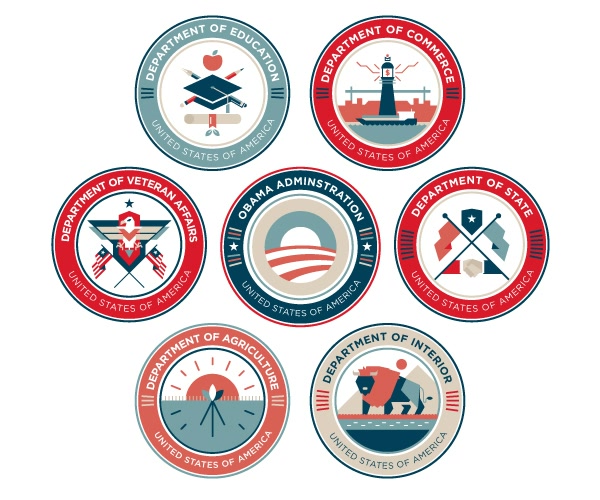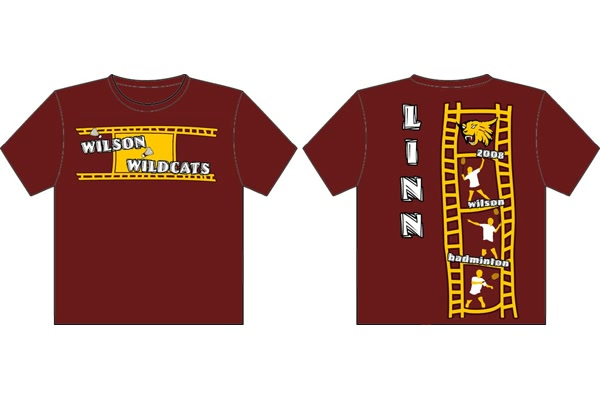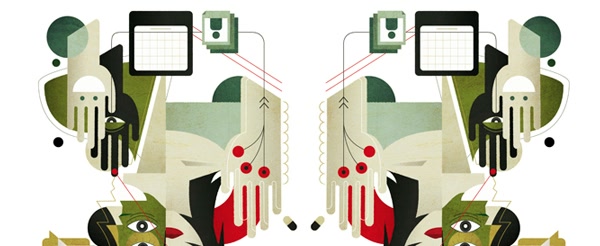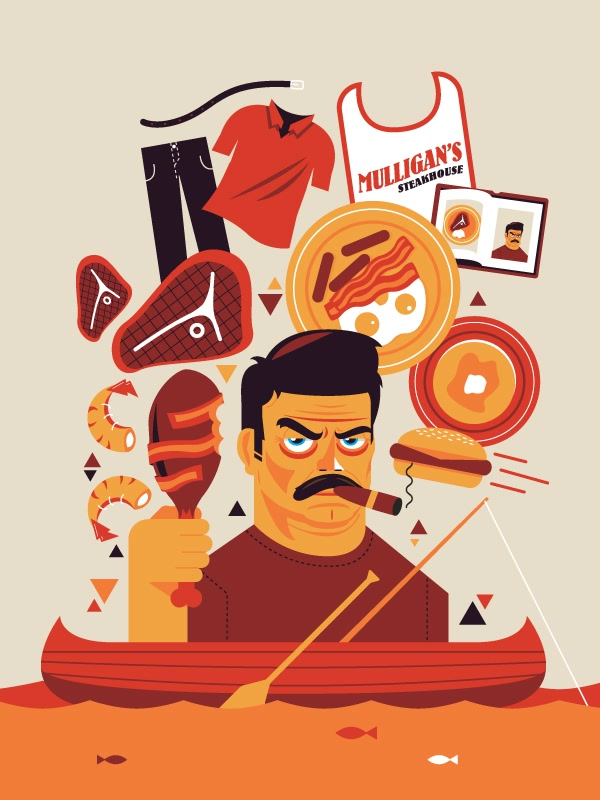One Minute With…
Ricky Linn

Hi Ricky, thanks for taking time to chat with One Minute With. Tell us a little bit about yourself and your work.
Hi! Thanks for having me. I’m a 20 year old graphic design student that’s currently in the trenches of Art Center in Pasadena, California, trying to earn my stripes and make my way into the world of graphic design. I freelance projects on the side to pay the rent and in my rare free time try to remember that I’m still relatively young and try to do young people related things.
Walk us through a typical day in the life of Ricky Linn.
On a typical day I spread myself across school projects, sometimes client projects, and my own personal endeavors. All while constantly checking in between Twitter, Facebook, my Google Reader feed, and my Tumblr. I try to squeeze in some time for Netflix when I get the chance, usually as I’m eating.
I’m always loaded with projects so routine is certainly not something that I have nailed down. Every new semester of school brings about schedule shifts and new freelance opportunities and I try to adjust accordingly, though the lack of sleep is one constant that will probably never change, haha. Recently I’ve started using TeuxDeux to keep myself somewhat organized and track things I need to stay on top of, and taking care of said things at my local coffee shop. I’ve been trying to make a habit out of reading books and articles on my iPad as well.

How did you get into design?
Completely by accident actually. About four years ago while I was in my high school’s badminton team my coach wanted someone from the team to design the team’s T-shirts for the season. I had been messing around in Photoshop for a while and thought I would take a crack at it and volunteered. Naturally it came out looking quite horrible, but the rest is history. It was about a year later as I was about to graduate high school that I decided to study graphic design formally, with great opposition by my parents.
Before any of this I had resigned myself to majoring in some kind of social science like anthropology or history.

How do you approach a new project? What’s your creative process like?
In the words of Frank Chimero, who I look up to a lot: ”I bash my head up against my desk like everyone else. We’re all the same.” I have been very lucky thus far, especially in the freelance world, that I have been trusted the creative freedom to create projects under my own aesthetic terms.
But nonetheless it always starts with research. I gather whatever significant data and information I can on the topic at hand, try to digest all of it, and formulate a few concepts in my mind. Then I bust out my trusty notebook and get to sketching out ideas. I’m not a great draftsman by any means so all of my sketches look like indecipherable scribbles and notes. I find that my best ideas always come from when I’m in Illustrator moving shapes around and exploring that way. But I usually skip back and forth between the two mediums. After I have honed in on one or two strong concepts I start looking for visual inspiration that speak to me and I feel is appropriate for the project.
At the end of the day I try to find that perfect marriage between what the projects requires and my own personal philosophy. Of course all of this would not be possible without the company of good coffee and good music.
You’re studying graphic design in Art Center College of Design in California. With the design industry changing at such a fast rate, how important is a formal education in design, do you feel?
This is a question that I have been struggling with myself as well, so bear with me for the long answer. Before I started at Art Center I was simply creating things that I found cool or aesthetically pleasing. There wasn’t much thought put into it and I was making things by the seat of my pants.
But each semester I learn more and more about the fundamentals of great design and no matter how much our industry changes, those fundamentals won’t. A formal education in school is incredibly useful for building a foundation and discovering your own philosophy on what design means to you and your community, locally and globally. It opens up your mind to all of what has come before you, and the amazing possibilities that lie ahead of you. Design is becoming more and more relevant everyday and the demand for our talents is only going to increase. And while a formal education is not a necessary ingredient for a great career, I have noticed that more and more companies, creative or otherwise, require a degree to simply get your foot in the door.
That being said, I have come to realize that no matter how much a school taunts their penchant for forward thinking and innovation, a school is still a business. There are hoops to jump through and strings to pull. And in that regard, a formal education cannot always keep up with the rapid changes in our field. And the answer to that really is just a DIY approach. We are in an incredible era where any and all kinds of information are at your finger tips. You can learn anything you want with motivation and discipline, at almost no monetary cost except for an internet connection. And that is the only way so far that we as designers can keep up with new methods and practices and technologies that sometimes schools are just not ready to throw into their curriculum at a whim, for whatever reason.
So in summary the way I see it, a formal education is a double edged sword. But at the end of the day it comes squarely down to you as an individual how much you want to stay relevant. It is tricky, as I am experiencing now, to split my time and enthusiasm between doing school projects so I can have great portfolio pieces for when I graduate, and finding time for personal exploration and building my own desired repertoire of skills.
There are of course other factors that can be brought into the discussion but I’ll stop here for the sake of not extending this any further.

Your work has a vintage feel, with modernist influences. Where do you get inspiration?
I’m really glad you say that because it means I’m getting my personal style across. That is exactly where my influences come from. As I have mentioned school is a great place to expose yourself to what has come before you.
Last semester over the course of this summer I took an Introduction to Modernism course and was incredibly lucky to have a great instructor teaching it. She really opened my mind to the incredibly rich history of early to mid-century graphic design. Given my general interest in history and graphic design, I fell absolutely in love with all of it. I was blown away by how those designs, crafted over fifty years prior without the aid of any computers, were able to stand the test of time and look as contemporary as they do today. Suprematism, Constructivism, Minimalism, De Stijl, Bauhaus, etc. All these schools of thought have incredible influence on my style of work. The work of Alvin Lustig, McKnight Kauffer, and El Lissitsky, to name just a few, are also incredible inspirations.
Before I took that course I had been emulating those styles into my work simply because I liked the way it looked, having seen some random bits of work online from Ffffound and such, not knowing who had done it or why. But now I understand why I like it and what it means to create such work, and it pushes me to follow in their footsteps.
Then there are of course all the contemporary designers who are creating great work today whom I like to call my design heroes: Frank Chimero, Mikey Burton, Richard Perez, Evan Stremke, Mark Weaver, Ty Wilkins, Tim Boelaars, Brent Couchman, Scott Hill, Mike Lemanski, the pair at Always with Honor and Eight Hour Day, the list is endless. As students we are in no short supply of heroes to choose from.

If, in some Freaky Friday-like situation, you could live the life of another designer, illustrator or creative, for a day, who would it be, and why?
There so many, but I would love to be Charley Harper and experience the way he works and illustrates. What was running through his head as he worked? I could stare at his illustrations all day. The retrospective of Charley Harper’s life and work by Todd Oldham is probably the best book I’ve ever purchased. I have a great love and fascination of animals and nature ever since from a young age and a big part of my youth was spent watching nature and history documentaries. He combines both my love of wildlife and the geometric modernist aesthetic. It definitely helps that he was incredibly amazing at what he did. My 365 Animals project is without a doubt a tribute to him.
What design tools could you not live without?
There are certainly many things a creative needs, but for me it all boils down to: a notebook, a ballpoint pen, Illustrator, a keyboard+mouse, good music, and an internet connection.

And finally, what tips would you give to anybody who is looking to get started in design or illustration?
I don’t know how qualified I am to be giving advice at this point but for what it’s worth, I do have a few things I have learned over the past few years.
Self-motivation is so important to getting better. No one wants you to succeed more than you. So stay motivated and keep pushing the limits of what you can and want to do. Don’t wait for someone to push you to do better. As you may have heard countless times, design is not a job you do, it is a lifestyle you live.
Don’t be afraid to show work you’re proud of, especially as a student. Post them wherever you can build yourself a presence online, whether it be your own personal site, Tumblr, Twitter, Dribbble, etc, account. Nothing bad can come of it and can only help to gain you some exposure and get your feet wet into networking with other designers and land you some potential clients. I have been really fortunate that all my freelance clients have come to me because they have seen my work from which ever corner of the internet that they may have found it.
And lastly this is something I am still having difficulty internalizing myself but I feel is invaluable to students moving forward professionally. Keep your ego in check and be patient with yourself. As students we often times have unrealistic expectations to become great really quickly. I certainly did. We look to those above us and admire their successes, without contemplating what it took to get there. I struggled for a long time in feeling confident about my own work because of voices both inside and outside my head saying that I can’t do it. Only now am I starting to feel more secure about my credibility as a graphic designer. It takes time to build yourself up from the ground, both in skill and maturity.